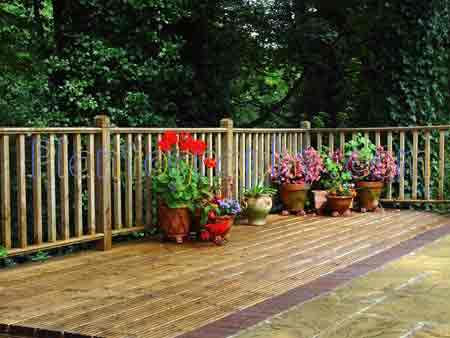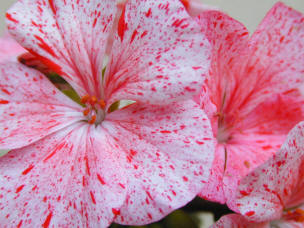Best 10 Ferns for Shade gardens
There is a mistaken belief that all ferns are happiest in shaded
parts of the garden. Some are most certainly not, whilst others
can put up with half sun and half shade – dappled shade.
This list will give you some ideas for best ferns in the different shade
areas of the garden – dry shade and damp shade
Our
best selection of shade loving ferns includes both evergreen and
deciduous ferns. Many are suited for growing in containers – the
evergreens are particularly useful for this. All ferns are happy in
association with other groups of plants – shrubs and perennials if the
soil conditions are suitable.
You may have to hunt round many garden centres or try a specialist nursery. Most ferns are sold as reasonably mature specimens in containers, and are quite easy to establish if you follow the cultural instructions for the individual varieties.
Ferns are not only green in colour. There are several with different
shades of pink and a couple of variegated forms with interesting
foliage. Again, there is a wide variation in the foliage types. You
could not want a more different foliage variation, than those of the
Hart’s Tongue fern and the Maidenhair types
All of the ferns we list in this section are hardy in all but the most severe of winters, but it is always best to give a little winter protection to protect the crowns of prized specimens.
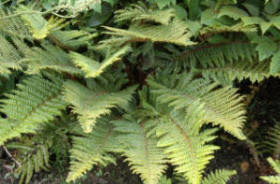
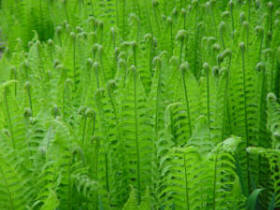
Left - Polystichum polyblepharum - Right - Matteuccia
struthiopteris
Top Ten List for Shade
- Maidenhair fern Adiantum pedatum. This is not the same Maidenhair Fern sold for indoor use, but a well hardy smaller fern – often found in rock crevices or dry-stone garden walls. Prefers dry-ish conditions but will tolerate full shade – though always nice if ‘dappled’ by sunlight flitting through trees.
- Hart's-tongue ferns – Asplenium have lanceolate rather than fronded leaves. Of particular use and attraction if the ‘Crispum’ wavy edged leaves of Asplenium scolopendrium Crispum
- Athyrium filix-femina – The Lady Fern, is a native to the UK and fully hardy, with attractive fern fronds. Damp shade seems to be the best – though will grow in most moist areas.
- Polypodium vulgare 'Pulcherrimum' – The common Polypody – used in several forms of cooking – because of its unusual scented leaves, and also in traditional herbal applications. Attractive foliage and spreads via hairy stolons. Good for ground cover.
- Garden Ferns Main Page
- Top 10 Hardy Ferns
- Polystichum varieties,
- Polystichum polyblepharum – Damp shade, evergreen in milder areas. Happy in clay soils, and not bothered about acid or alkaline soil. Non-invasive good ground cover and particularly suited to growing in association with shrub cover.
- Polystichum divisilobum group – Damp shade – but also does well in dry woodland. Very attractive fern fronds with small bulbils on the end of the individual frondlets. Easy for propagating. Deciduous.
- Matteuccia struthiopteris – Ostrich Feather or Shuttlecock Fern with upright fronds reaching a meter in height. Stunning sight in the spring as the new fronds rear up before unfurling.
- Dryopteris filix-mas – the Male Fern is always a favourite – easy to get and easy to keep. A good coverage of ferny fronds – though not fully evergreen, but rather semi evergreen. Damp or dry places with a positive preference for shade though will tolerate dappled sunshine.
- Dryopteris affinis - The Golden Male Fern. Semi to fully evergreen depending upon situation for growing. One for moist soils – almost boggy even – in a woodland setting where it is at home! The new foliage is light green – almost lime green, but then changes to a dark green mass of fronds – open and upright, as with the shuttlecock type ferns. Propagate by spores – not easy.
- Onoclea sensibilis. The Sensitive Fen – or Bead Fern A fern best suited to damp areas of shade where it will provide a spreading carpet of bright green fronds rising from the creeping rhizomes. Not evergreen but well worth trying. Susceptible to strong sunlight – hence its common name of The Sensitive Fern. We know nothing of the bead-like seeds which gives it the other common name. Have never experienced them growing. Easy to propagate – simply divide the clump in late winter or early spring.
Others to try include Dryopteris erythrosora which has purple red young foliage with a little variegation.
Best Selling Gardening Products
Popular Gardening Sections
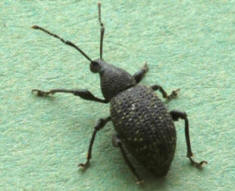
Problems
Identify Weeds in The Garden - How to deal with weeds. Diseases and Pest which harm your garden and plants, learn how to prevent, deter and erradicate your garden problems.
Garden Problems
Pruning
Pruning Guide. Shrubs flower better with correct pruning. Many illustrations and examples of what to do - and when. Includes evergreens, roses, flowering shrubs, spring flowering shrubs and pruning for stem effect. This is our most viewed and comprehensive section,
Pruning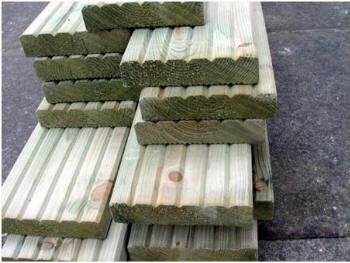
Gardening Businesses
Gardening Businesses listed in the UK counties and USA states. County and State Listings of businesses involved in Garden supplies and services. If you wish to be added to the Directory, please send us your information. Having problems, use the search box
Businesses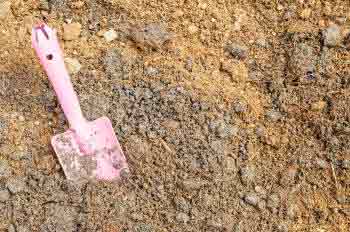
Gardening
In this section you will learn about Gardening Basics, Containers, Landscaping, Propagation and Soil.
Gardening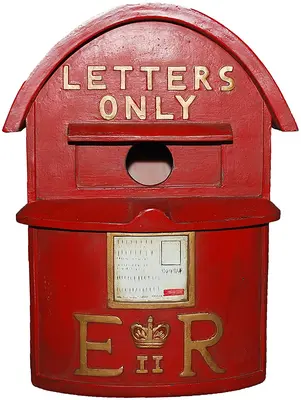
Gardening Gifts
Gardening Gifts and Reviews, Read Before you Buy
- Gardening Gifts Ideas
- Gifts For Her
- Gifts For Men
- Power Tool Gifts
- Cheap Gifts
- Personalised Gifts
- Wildlife Gifts
- Family Gifts

